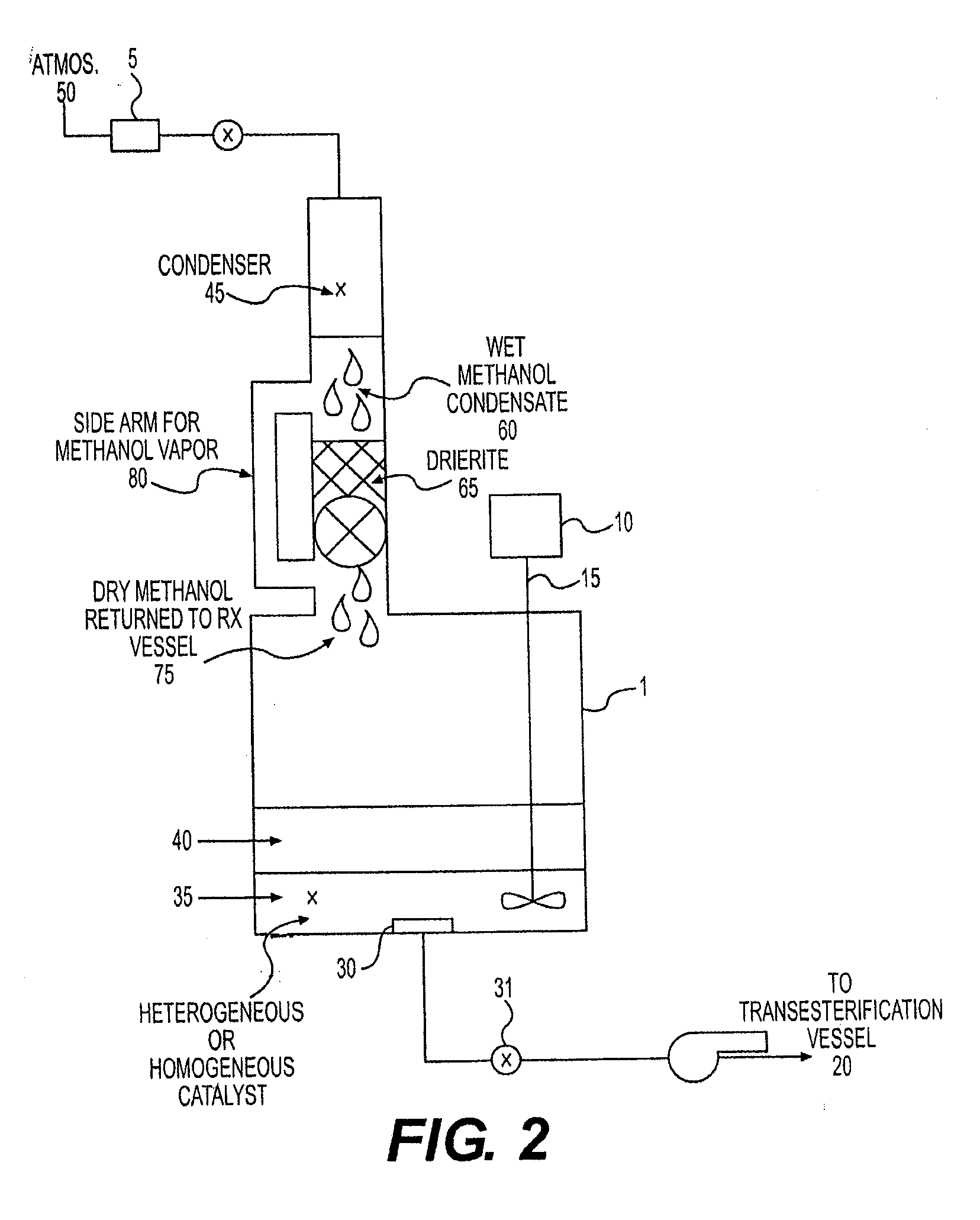Process and system for preparation of bio-fuels
a biofuel and process technology, applied in biofuels, chemical/physical/physicochemical processes, fuels, etc., can solve the problems of inability to use oils of higher than 5% ffa, inability to achieve the effects of reducing the cost of raw materials, and increasing the percentage of free fatty acids
- Summary
- Abstract
- Description
- Claims
- Application Information
AI Technical Summary
Benefits of technology
Problems solved by technology
Method used
Image
Examples
experiment # 1
Experiment #1—Homogeneous Catalysis by a Standard Method (1× Standard)
[0064]A 250 ml three-necked, round-bottomed, standard taper flask was fitted with a reflux condenser (terminating in a drying tube to exclude moist air), a thermometer dipping into the flask contents, and a stirring gland / stirring shaft assembly with paddle. Into the third neck of the flask was introduced 100 g of stabilized poultry fat (SPF with a FFA content of 10%) and a solution of 0.5 g of sulfuric acid (98% H2SO4) dissolved in 29 ml of anhydrous methanol, and the neck stoppered.
[0065]The flask was heated with a water bath, with stirring (120 rpm), where the internal temperature of the reaction mixture was maintained at about 60° C. A sample of the oil phase was removed after one hour and found to be 1.1% by titration with 0.1% aqueous sodium hydroxide to a phenolphthalein endpoint.
experiment # 2
Experiment #2—Homogeneous Catalysis with Continuous Drying Using Suspended Drierite (½Standard)
[0066]Using the same set up and procedure as Exp. #1, the following were introduced to the flask:[0067]100 g SPF (50% FFA)[0068]74 ml methanol[0069]1.3 g H2SO4[0070]50 g Drierite
After 1 hour at 60° C., with stirring, a sample was removed, found to be 0.42% FFA. Thus, the goal of =2SO4 and a feedstock with five times the level of FFA (50%) using continuous drying with Drierite.
experiment # 3
Experiment #3—Heterogeneous Catalysis with Nafion and Suspended Drierite
[0071]A 250 ml three-necked, round bottom, standard taper flask was equipped with a reflux condenser and thermometer (as above) and a magnetic stirring bar. The following were introduced to the flask, through the third neck, which was then was stoppered:[0072]58.5 g SPF (10% FFA)[0073]44 ml methanol[0074]17.5 g Hi-cat 1100 (Nafion)[0075]10 g Drierite
The flask was immersed in an oil bath and the flask contents heated at 60° C., while the contents were magnetically stirred (using a hot plate / magnetic stirrer). After one hour, a sample of the oil phase was found to be 0.47% FFA.
PUM
| Property | Measurement | Unit |
|---|---|---|
| temperature | aaaaa | aaaaa |
| temperature | aaaaa | aaaaa |
| temperature | aaaaa | aaaaa |
Abstract
Description
Claims
Application Information
 Login to View More
Login to View More - R&D
- Intellectual Property
- Life Sciences
- Materials
- Tech Scout
- Unparalleled Data Quality
- Higher Quality Content
- 60% Fewer Hallucinations
Browse by: Latest US Patents, China's latest patents, Technical Efficacy Thesaurus, Application Domain, Technology Topic, Popular Technical Reports.
© 2025 PatSnap. All rights reserved.Legal|Privacy policy|Modern Slavery Act Transparency Statement|Sitemap|About US| Contact US: help@patsnap.com



